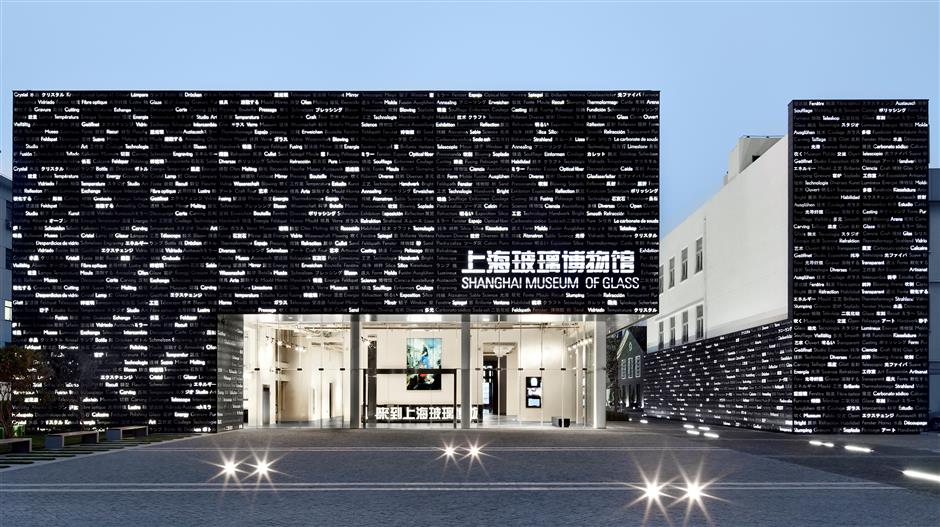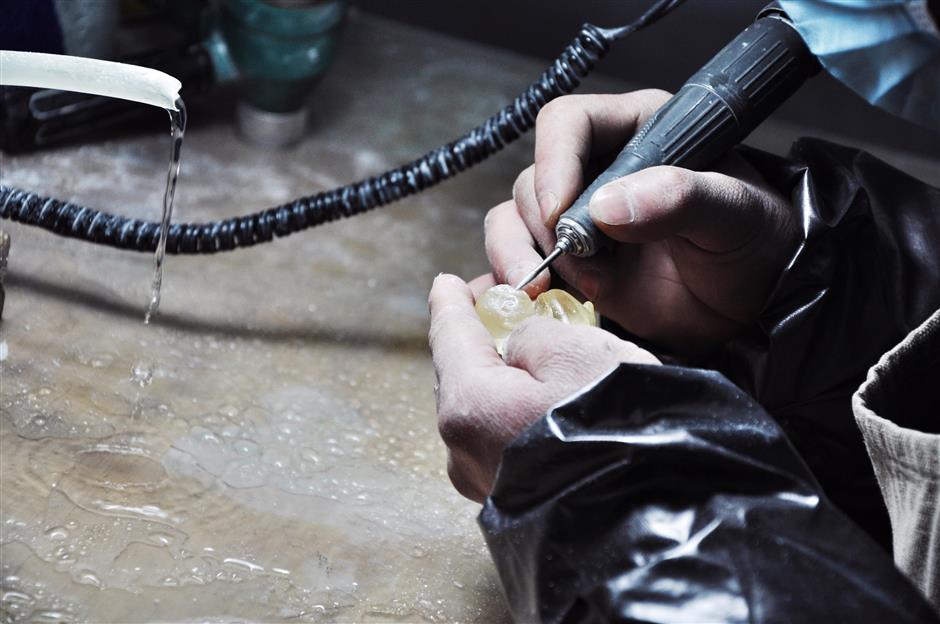Through the looking glass, a museum that sparkles

Shanghai Museum of Glass offers children a fun place to explore the crystal world with music.
Glass is so commonplace in our lives that it’s easy to dismiss it as just a cheap, ho-hum material. The Shanghai Museum of Glass shatters that perception.
Renovated and redesigned from the dilapidated old Shanghai Glassware Factory, the museum, which opened in 2011, traces the history, culture, production and art of glass in sparkling exhibitions.
Nature is the original glassmaker. Obsidian is naturally occurring black glass formed when hot lava cools rapidly.
The history of human glassmaking dates back at least 3,600 years to Mesopotamia. The earliest known glass objects were beads made in the 3rd millennium BC. In China, the earliest evidence of glass manufacturing puts it in the Warring States Period (475 to 221 BC. During the Han Dynasty (206-220 AD), evidence has been found of glass molded into objects.

The glistening façade of the museum
A giant black glass wall emblazoned with the word “glass” in dozens of different languages greets visitors. It’s best to take photos in front of the wall at sunset, when the evening glow reflects from the smooth surface.
Stepping into the main hall is like venturing into a kaleidoscope. Everything -- from the ceiling to the floor and fixtures – is crystal and shining.
The hall displays how ancient people discovered the ingredients of class and how techniques of glassmaking have developed over the centuries. An interactive video on large screen LCDs shows how common sand is miraculously turned into glass.
A “Silk Road” lit by glass lamps links Eastern and Western glassmaking history and culture. The exhibits include glassware from ancient Rome, painted Chinese snuff bottles from the Qing Dynasty (1644-1912), colored and glazed cups and dishes from Persia, and the old tools used to make glass.

A magical kaleidoscope show of traditional dance performances on a glass stage
Of course, glass is fragile. One of the halls in the museum currently hosts an exhibition called “BRKN,” mounted by the curator and the museum’s designer, German architect Tilman Thürmer. It will run through the end of the year.
BRKN shows how glass shatters, fractures and cracks – a metaphor for heartbreak, bad luck or even hope. Twenty-one installations explore the connotations, implications, and possibilities of broken glass.
One of the most striking installations there is entitled “Unbreakable.” A speeding car made of a ton of steel, rubber and glass slams to a halt after hitting an unyielding obstacle -- an ethereal beam of light. The work calls into question the potency of power and the duality of opposing forces in the world.

A swimming pool filled with broken glass in a BRKN installation
In BRKN, heartbreak is exemplified by a series of installations that shine a light on emotional associations. The work “Fragile,” inspired by the eponymous song calling for compassion and tender care, is a glass art piece with its lyrics realized in mouth-blown neon on a seven-meter high wall. Those towards the top of the work are intact, leading to broken ones as the eyes move lower.
In BRKN, visitors can walk on broken glass pieces to feel the cruelty of dreams shattered, and they can actually break class in an installation where wine glasses can be smashed.

A glass guitar generates rock music when visitors position themselves in the right spot.
Annealing is an essential part in creating glass art, and also a key to its final formation. It’s a time-consuming process. What is really fascinating is the unknown and uncertainty in annealing that can result in unpredictable glass artwork.
Since 2014, the museum has hosted the annual art project called “Annealing.” It invites contemporary artists to create works in glass, giving their interpretations of the annealing process.
Currently, the project’s two exhibitions, “Mirror Effect” by porcelain artist Liu Jianhua and “Frontier” by painter and animated film director Sun Xun, will be on display through next May 31.

A glass-and-steel ladder leads up to the second floor of the BRKN exhibition.
The Kids Museum of Glass, the country’s first glass-themed, family-oriented cultural destination for children, is a happy castle for children and the coolest place to interact and learn. Don’t miss the Glass Maze. When children walk through the dim-lit, mirror-made glass alleys, they are given a lesson in bravery and independence of spirit.
The Radiance Theater is an open glass-blowing work studio equipped with an oven that can heat up to above 1,200 degrees Celsius. Here, visitors can watch how glass is blown and annealed by fire. Adult visitors are invited to try their hand at making a glass piece, under the careful guidance of professional glassblower.

A glass blower heats the long pipe used to create pieces of fine art in the museum’s Radiance Theater.

An artisan etches on glass in a museum workshop.
In another workshop, children can color a glass pumpkin or penguin and help dry the pigments with an air blower.
If you go
Address: 685 West Changjiang Rd, Baoshan District
Admission: 60 yuan (US$8.60) each for the main hall, the children’s museum, the maze, the BRKN exhibition and Radiance Theater. A 160-yuan package gives visitors entry to three venues and half-price (30 yuan) admission to the fourth and fifth venues. Closed on Mondays.
Transport: Take Metro Line 1 to Tonghe Xincun Station and then bus 726 or 95 to San Zhuanlu. Or Take Metro Line 3 to the South Changjiang Road Station and take bus 552 or 88 (Baoshan) to San Zhuanlu.
















